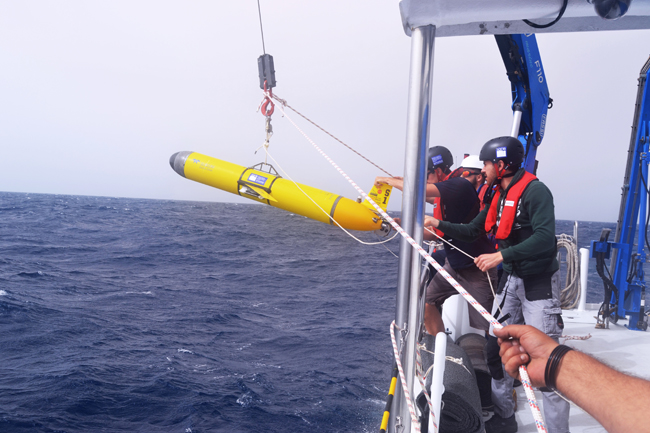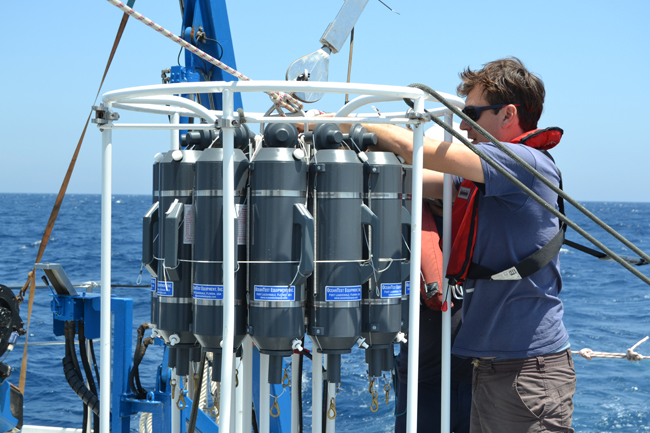
Data assimilation: towards more realistic oceanic model predictions integrating observations
01/04/2019
Are there areas in the Mediterranean where plastics accumulate? If the average seawater temperature increased by one degree, where would the fish stocks migrate to? Where should we place containment booms to hold in a toxic spill? Where should we look for a sailing boat that is adrift? Do we need a dry suit if we want to go diving tomorrow? All these questions can be answered in an ever more precise and reliable way, using science and developing ocean forecasting models.
The movement of a fluid is profiled using mathematical equations which depend on the wind, atmospheric pressure, solar radiation, the viscosity of the fluid itself, the force of gravity, and even the latitude we are at. The use of all these mathematical equations in computer language and their solutions translates into what are known as “numerical models”. The fact that both air and water are fluids (one is gas, and the other is liquid) gives rise to the existence of atmospheric and oceanic models, respectively, although, due to the complexity of the ocean and the lack of knowledge about it, oceanographic models did not start to be developed until the 1960’s, forty years after the first weather forecasting models.
Currently, one of the main aims of oceanography is to predict oceanic weather, in a similar way to the weather, by following many of the advances achieved in atmospheric sciences. However, the difficulty of monitoring the marine environment, both in space and time, affects the availability of data for forecasting. Due to technological advances, we currently have various data collection instruments (underwater gliders, radar, oceanographic buoys and satellites, etc) to monitor the ocean. This is what we call a “multiplatform perspective”.
In this context the MEDCLIC project’s numerical modelling and forecasting team has improved its forecasts by using a methodology initially imported from atmospheric sciences, known as “data assimilation”. This technique consists of getting more precise ocean forecasts by integrating real data obtained from oceanographic instruments into oceanic models and making them converge towards those values. In this way, model predictions are prevented from veering towards irrealistic conditions (see figure 1).

Figure 1. Data assimilation models (green) are helped by observations to produce more realistic forecasts, that is to say, closer to real observations.
To advance on this, sensitivity experiments must be carried out considering various sets of observations obtained directly from the sea with the oceanographic instruments making up the SOCIB multiplatform system. This evaluation process takes into account the balance between computer use, the cost of the observations themselves and the improvement on the model performance.
One of these experiments was recently published in the international “Ocean Science” journal. The purpose of the Article was to compare output (forecasts) from the WMOP model when assimilating data from the eight underwater gliders, on the one hand, and Conductivity, Temperature and Depth (CTD) probes, on the other.


Photos 1 and 2. The underwater glider and the CTD (CDT-Rosette), two of the data collection instruments which are part of the SOCIB multiplatform system for monitoring the ocean, during a data assimilation experiment.
The article highlights how the system is capable of ingesting information from both observation sources at different levels and concludes that the observations supplied by either the eight gliders or the dense CTD probes sampling, allowed us to reduce the forecasting error by 40%.
These kinds of experiments are fundamental when it comes to designing strategic plans for future observations and development of ocean forecasting models.
Currently, and based on the results of previous experiments, SOCIB already has a trial version of a forecasting model which includes data assimilation using data from satellites and ARGO buoys. This version has been used successfully over the past few months and has shown itself to be more precise and reliable on the WMOP model without assimilation.
By way of applied examples, we can mention planning for the international CALYPSO project, where data assimilation helped to calculate the most appropriate sampling sites, and advising on charting the optimum route where the currents would not prevent the swimmer, Tita Llorens, from achieving her goal of swimming across the Ibiza Channel.
MEDCLIC: fundamental for researching ocean processes
The MEDCLIC project has been studying oceanic processes in the Mediterranean since 2014, combining data about the sea obtained from SOCIB’s different oceanographic instruments with satellite observations, and developing oceanographic models. These are essential tools for predicting ocean behaviour and its impact.
Post published on the CaixaCiencia Blog on 13/12/2018
